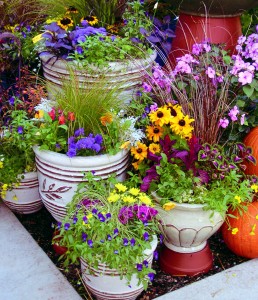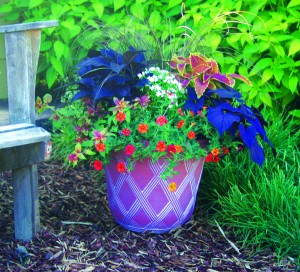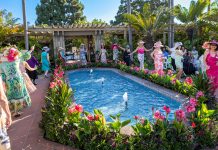 By Tom Snyder | Special to the NB Indy
By Tom Snyder | Special to the NB Indy
Whether one has a yard or not, everyone can garden. Even the humblest recycled container can hold a garden. And given that California’s water supply is so limited right now, gardening in pots may be the coolest thing a gardener can do.
Small-scale gardening of any sort—in containers or just in a limited space—uses the same principles and good practices that gardening on any scale takes. And while the mistakes are minimized, the rewards and satisfaction are not.
With container gardening, you’ll still want to use good quality materials, you’ll still have to obey Mother Nature, and you’ll want to use good design principles. But most everything else becomes simplified.
A Few Musts
When gardening in pots or containers of any kind, they must have drainage holes, otherwise roots will not have the oxygen they need.
Your plants will also need more frequent watering and feeding than they would if they were in the ground. The soil is more exposed to heat and wind and therefore dries out faster, while more nutrients are needed because of leaching and limited root space.
What to Use
Use high-quality potting soil (not planting mix) and an organic starter or pre-plant fertilizer. This will get your plants off to a healthy, vigorous start. Make sure the soil is well-compacted.
Combining Plants
You’ll want to combine plants with similar light and water needs, otherwise some will suffer. Check the tag for details before purchasing.
The TFS Principle
Whether it’s edible or ornamentals, for visually pleasing container gardens, use the TFS principle: choose a plant that’s tall and vertical (thriller), a plant that’s mounding (filler), and a plant that trails (spiller). This combination will provide interest at all levels and will soften the edges of the pot. You may choose to use more than one filler and spiller.
combination will provide interest at all levels and will soften the edges of the pot. You may choose to use more than one filler and spiller.
Combining Color
As in any garden situation, combining color is simple: make sure adjacent plants echo (repeat) a color from plants nearby. It may be a color in the center of the flower, a petal’s edge, a leaf or even a stem color. If you follow this rule, you’ll always have harmony.
Simple Statements
Single plants in a pot or container—especially if the container has a lot of interest itself—grouped with other single-plant pots can be visually striking and more effective in a small space. Multiple pots containing unique plants can be very dramatic.
Color from Foliage
For the last few years, nurseries have been well-stocked with plants with fabulous foliage. You’ll find leaves in gorgeous colors and interesting textures. No need to wait for flowers—you’ve got instant color! And if plants go out of bloom, no problem.
Care
Watch your plants to understand their water need rhythm. Plants will wilt when they need water. Generally, with container gardens in sunny spots, you’ll need to water every other day. With shade plants, twice a week should be sufficient. Keep in mind that simple terracotta pots dry out faster than plastic or glazed pots due to their porous nature. Never let a pot sit in water in a saucer or tray.
Feed plants monthly with a granular organic (or timed-release) food according to directions. For heavily-flowering plants such as annuals, you may want to use a granular food and a liquid high-bloom fertilizer at half-strength. This will ensure a spectacular show of color.
Tom Snyder is a California Certified Nursery Professional and the manager of the Armstrong Garden Centers located at 1500 East Coast Highway in Newport Beach. Email him your gardening questions to growingdialogue@armstronggarden.com or call (949) 644-9510.




